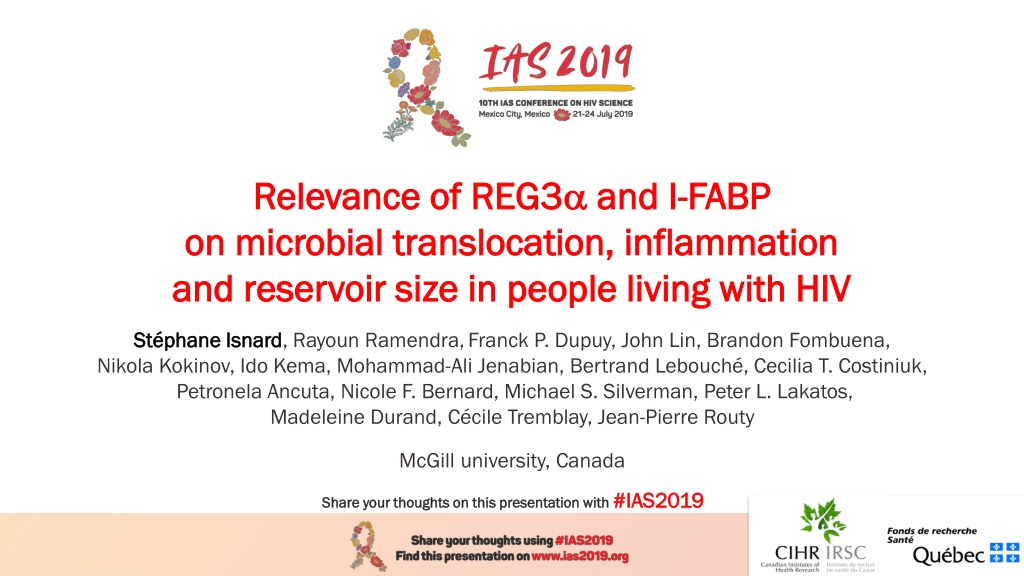Role of REG3 and I-FABP in HIV-Related Gut Permeability and Inflammation
This presentation highlights the significance of Regenerating Islet-Derived Protein-3 (REG3) and Intestinal Fatty Acid Binding Protein (I-FABP) in microbial translocation, inflammation, and reservoir size in individuals living with HIV. REG3 and I-FABP serve as markers of gut epithelial damage and permeability, with elevated levels observed in conditions like GVHD, coeliac disease, Crohn's disease, and ulcerative colitis. Plasma REG3 levels are notably higher in people living with HIV, including elite controllers, and research correlates REG3 and I-FABP levels with HIV, inflammation markers, and CD4 T-cell count. The association between REG3 and I-FABP sheds light on their role in HIV pathogenesis and may offer insights into potential therapeutic strategies.
Download Presentation

Please find below an Image/Link to download the presentation.
The content on the website is provided AS IS for your information and personal use only. It may not be sold, licensed, or shared on other websites without obtaining consent from the author. Download presentation by click this link. If you encounter any issues during the download, it is possible that the publisher has removed the file from their server.
E N D
Presentation Transcript
Relevance of REG3 Relevance of REG3 and I on microbial translocation, inflammation on microbial translocation, inflammation and reservoir size in people living with HIV and reservoir size in people living with HIV and I- -FABP FABP St phane Isnard St phane Isnard, Rayoun Ramendra,Franck P. Dupuy, John Lin, Brandon Fombuena, Nikola Kokinov, Ido Kema, Mohammad-Ali Jenabian, Bertrand Lebouch , Cecilia T. Costiniuk, Petronela Ancuta, Nicole F. Bernard, Michael S. Silverman, Peter L. Lakatos, Madeleine Durand, C cile Tremblay, Jean-Pierre Routy McGill university, Canada Share your thoughts on this presentation with #IAS2019 #IAS2019 Share your thoughts on this presentation with
Gut permeability vs. gut damage Gut permeability vs. gut damage REG3 I-FABP Regenerating islet-derived protein-3 Intestinal fatty acid binding protein REG3 - C-type lectin acting as an antimicrobial peptide Constitutively produced and secreted in the gut lumen by Paneth cells Translocate in the mucosa then blood only upon loss of epithelial cells-to-cell interaction Circulating levels are elevated in GVHD, Coeliac and Crohn s disease, ulcerative colitis - Intracellular protein only expressed by enterocytes Found in the mucosa and blood upon enterocyte cell-death Circulating levels are elevated in enteropathies and people with chronic HIV infection. - - - I-FABP I-FABP - I-FABP I-FABP REG3 - Marker of gut epithelial damage Marker of gut permeability Major-Monfried et al. Blood 2018 Zhao et al. J Clin Invest 2018 Marafini et al. Aliment Pharmacol Ther 2014 Cheru et al. Op Forum Inf Dis 2018
Plasma REG3 Plasma REG3 levels are elevated in PLWH, including elite controllers levels are elevated in PLWH, including elite controllers <0.0001 <0.001 <0.0001 <0.001 <0.0001 n.s. n.s. <0.001 0.006 0.027 4000 3000 <0.0001 n.s. <0.001 0.048 REG3 (pg/mL) 3000 I-FABP (pg/mL) 2000 2000 1000 1000 0 0 EC UC CHI ART+ Plasma levels of REG3 , but not I-FABP, decreased with ART. EC UC EHI ART- CHI ART- CHI ART+ EHI ART- CHI ART-
Association Association between between REG3a and I REG3a and I- -FABP HIV and inflammation markers HIV and inflammation markers FABP with with different different Parameter REG3 r=0.24 p=0.005 n=139 r=0.19 p=0.03 n=139 r=0.37 p=0.001 n=74 r=-0.41 p=0.0001 n=81 r=0.30 p=0.006 n=81 r=0.39 p=0.0003 n=81 I-FABP r=0.047 p=0.6 n=160 r=0.11 p=0.2 n=160 r=-0.0012 p=0.99 n=83 r=-0.031 p=0.8 n=87 p=0.12 r=0.3 n=88 r=0.12 p=0.3 n=87 Parameter REG3 r=0.53 p<0.0001 n=139 r=0.51 p<0.0001 n=190 r=0.44 p=0.002 n=47 r=0.2 p=0.2 n=47 r=-0.12 p=0.4 n=50 I-FABP r=0.11 p=0.2 n=160 r=0.17 p=0.04 n=160 r=0.16 p=0.3 n=49 r=-0.081 p=0.6 n=49 r=0.005 p=0.99 n=52 Parameter CD4 T-cell count REG3 r=-0.28 p=0.0003 n=161 r=-0.006 p=0.9 n=161 r=-0.29 p=0.0002 n=161 r=0.29 p=0.01 n=72 I-FABP r=-0.07 p=0.4 n=160 r=0.11 p=0.2 n=160 r=-0.35 p=0.7 n=160 r=0.002 p=0.99 n=72 LPS IL-6 Inflammation, immune activation Microbial translocation, gut inflammation Disease Progression DG IL-8 CD8 T-cell Count sCD14 IgG CD4/CD8 Tryptophan IgM Viral Load Kynurenine IgA Kyn/Trp spearman correlations
Plasma REG3 Plasma REG3 but not I are associated with integrated HIV DNA in CD4 T are associated with integrated HIV DNA in CD4 T- -cells but not I- -FABP levels FABP levels cells 0.21 0.08 0.37 r= p 0.006 r= p= (log10 copies/106CD4 T-cells) (log10 copies/106CD4 T-cells) 4 4 Integrated HIV DNA Integrated HIV DNA 3 3 2 2 1 1 0 0 0 1000 2000 3000 4000 0 1000 2000 3000 4000 REG3 (pg/mL) I-FABP (pg/mL) EHI ART- CHI ART- CHI ART+ EC
Poster TUPDA0103 Acknowledgments Acknowledgments McGill University Health Centre CVIS Dr Jean-Pierre Routy Rayoun Ramendra Dr Franck P Dupuy Dr Vikram Mehraj John Lin Jos e Girouard Angie Massicotte Brandon Fombuena Drs JG Baril, B Lessard, MA Charron, S Dufresne, ME Turgeon, S V zina, E Huchet, JP Kerba, M Poliquin, S Poulin, P Rochette, P Junod, D Longpr , R Pilarski, E Sasseville, L Charest, A Hamel, A Cloutier-Blais, S Massoud, F Chano, B Trottier Drs C Costiniuk, B Lebouch , A de Pokomandy, J Szabo, J Cox, LP Haraoui, M Klein Dr P Ancuta Dr N Chomont Dr C Tremblay Dr M Durand, Dr C Chartrand-Lefebvre Rejean Thomas Dr R Leblanc Montreal Primary HIV-infection cohort Canadian HIV infected Slow Progressors Canadian HIV and Aging Cohort Scholarship Thanks to all study participants 7






























